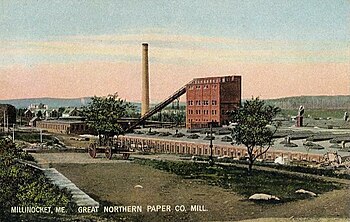Patten is a small town in Penobscot County, Maine, United States. At the 2020 census, the population was 881. The village of Patten is in the northeastern part of the town.

Millinocket is a town in Penobscot County, Maine, United States. The population was 4,114 at the 2020 census.
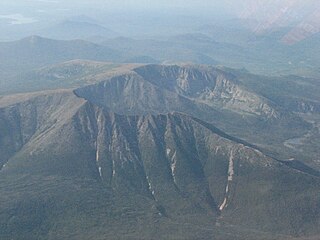
Mount Katahdin is the highest mountain in the U.S. state of Maine at 5,269 feet (1,606 m). Named Katahdin, which means "Great Mountain", by the Penobscot Native Americans, it is within Northeast Piscataquis, Piscataquis County, and is the centerpiece of Baxter State Park. It is a steep, tall massif formed from a granite intrusion weathered to the surface. The flora and fauna on the mountain are typical of those found in northern New England, with the summit hosting fragile and endangered alpine tundra.

The Penobscot River is a 109-mile-long (175 km) river in the U.S. state of Maine. Including the river's West Branch and South Branch increases the Penobscot's length to 264 miles (425 km), making it the second-longest river system in Maine and the longest entirely in the state. Its drainage basin contains 8,610 square miles (22,300 km2).
Fraser Papers Inc. was a Toronto, Ontario, Canada-based manufacturer of specialized printing, publishing, and converting papers, with customers in Canada and the United States. It managed more than two million acres (8,000 km2) of forest, operated a tree nursery, and sawmills. It was spun off as a public company in 2004 by parent Nexfor Inc., which became Norbord at the same time. Its stock traded on the Toronto Stock Exchange, under the symbol FPS.
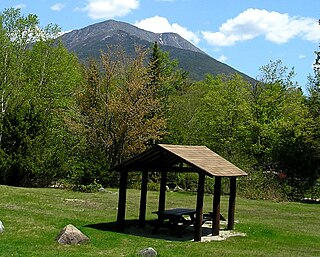
Baxter State Park is a large wilderness area permanently preserved as a state park in Northeast Piscataquis, Piscataquis County in north-central Maine, United States. It is in the North Maine Woods region and borders the Katahdin Woods and Waters National Monument on the east.
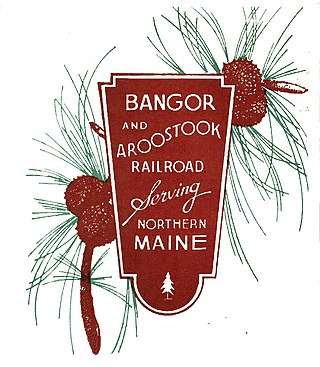
The Bangor and Aroostook Railroad was a United States railroad company that brought rail service to Aroostook County in northern Maine. Brightly-painted BAR boxcars attracted national attention in the 1950s. First-generation diesel locomotives operated on BAR until they were museum pieces. The economic downturn of the 1980s, coupled with the departure of heavy industry from northern Maine, forced the railroad to seek a buyer and end operations in 2003. It was succeeded by the Montreal, Maine and Atlantic Railway.

The Montreal, Maine and Atlantic Railway was a Class II freight railroad that operated in the U.S. states of Maine and Vermont and the Canadian province of Quebec between 2002 and 2014. It was headquartered in Hermon, Maine.

The North Maine Woods is the northern geographic area of the state of Maine in the United States. The thinly populated region is overseen by a combination of private individual and private industrial owners and state government agencies, and is divided into 155 unincorporated townships within the NMW management area. There are no towns or paved roads.

The Katahdin Iron Works is a Maine state historic site located in the unorganized township of the same name. It is the site of an ironworks which operated from 1845 to 1890. In addition to the kilns of the ironworks, the community was served by a railroad and had a 100-room hotel. The site was listed on the National Register of Historic Places in 1969.

WSYY-FM is a radio station broadcasting a full-service adult hits format. Licensed to Millinocket, Maine, United States, the station's broadcast signal serves Central Penobscot County, Eastern Piscataquis County, and Southern Aroostook County, from its tower site in Millinocket. The station is owned by Katahdin Communications, Inc.

The Pemadumcook Chain of Lakes are a set of large lakes in north-central Maine in the United States.

The West Branch Penobscot River is a 117-mile-long (188 km) tributary of the Penobscot River through the North Maine Woods in Maine. The river is also known as Abocadneticook, Kahgognamock, and Kettegwewick.
The Maine Northern Railway Company Limited is a 258 mi (415 km) U.S. and Canadian short line railroad owned by the New Brunswick Railway Company, a holding company that is part of "Irving Transportation Services", a division within the industrial conglomerate J.D. Irving Limited.
Charles P. Pray is an American politician from Maine. Pray was born in the paper mill town of Millinocket, Maine on August 15, 1945. He grew up in northern Piscataquis County, Maine attending a one-room schoolhouse from 1954-1959. He attended Maine Central Institute, graduating from Stearns High School in his birthplace of Millinocket in 1964. He then attended Ricker College in Houlton. In 1966, he enlisted with the US Air Force and served in Southeast Asia during the Vietnam War. Finishing with the Air Force in 1970, he returned to Maine and enrolled at the University of Maine, from which he graduated in 1973 with a B.A. in political science. In 1974, he was elected to the Maine Senate to represent Piscataquis County and the northern area of Penobscot County, which was the largest legislative district east of the Mississippi River. From 1978-1982, Pray served as Assistant Majority Leader of the Maine Senate. From 1982-1984, Pray served as Majority Leader. In 1984, Pray was elected by his peers as President of the Maine Senate, a position he held until a surprise defeat in 1992. He is one of two individuals to serve four terms but is the only Senate President in Maine history to hold the office for 8 full years.
The Golden Road is a 96-mile (154 km) private road built by the Great Northern Paper Company that stretches from the St. Zacharie Border Crossing to its former mill at Millinocket, Maine.
Schenck High School is a public high school in East Millinocket, Maine, United States. It is a part of the East Millinocket Schools. It serves East Millinocket, Medway, and Woodville.

Katahdin Woods and Waters National Monument is a U.S. national monument spanning 87,563 acres (137 sq mi) of mountains and forestland in northern Penobscot County, Maine, including a section of the East Branch Penobscot River. The monument is located on the eastern border of Maine's Baxter State Park. Native animals include moose, bobcats, bald eagles, salmon, and Canada lynx.
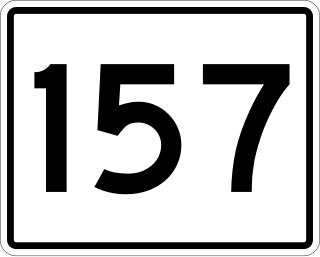
State Route 157 (SR 157) is a 22-mile-long (35 km) state highway in the northern part of the U.S. state of Maine. It travels between the towns of Millinocket and Mattawamkeag generally following the northern banks of the West Branch Penobscot River and the Penobscot River. For just under a half of its length, it is concurrent with SR 11 from Millinocket to Medway. This portion is also concurrent with the Katahdin Woods & Waters Maine Scenic Byway.

Old Town paper mill is an American paper factory in Old Town, Maine.

